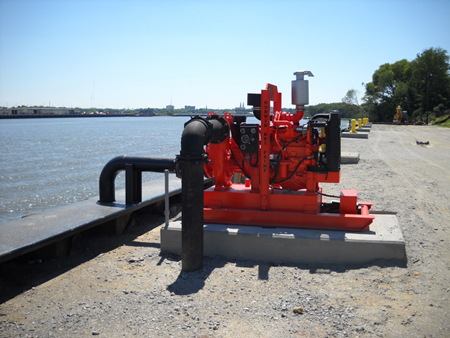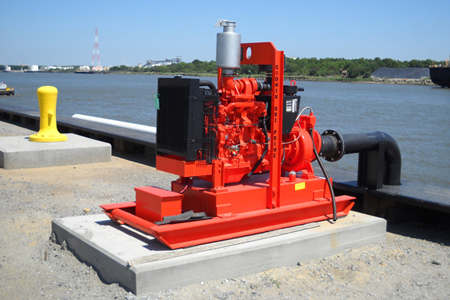Packaged pump systems used for more than sewer backup.
To the general public, the term pumping is as simple as moving liquid from Point A to Point B. While that mindset is true, the pumping community has continued to improve efficiencies in materials of construction, operation and performance and embrace technology in an effort to address an array of environmental challenges. In both temporary and permanent configurations, the evolution of the readily available packaged pumping system can incorporate features such as automatic controls, corrosion-resistant paint, solar-powered battery chargers and more. Such add-ons are increasingly offered as standard, packaged pumping/off-the-shelf solutions. These systems have evolved and expanded the impact of pumping applications that do more than just deliver water—they help protect and sustain our environment in extreme conditions including 150 degree temperatures, incredibly corrosive liquids and suffocating dust storms.
Putting Out Fires
Water is vital to every community and network and can be an incredibly scarce commodity. It is in high demand even in areas surrounded by water, where its accessibility and usability is counterintuitive, since providing the right kind of water for a need can remain a challenge. Consider fire suppression water sources on locations surrounded by water but with no city water access.
In this case study, a fire suppression system was needed that contained a permanently installed pump to pull water from the surrounding water source in an effort to supply steady flow to fire hydrants. Traditional pumping systems are used to supply fire suppression to buildings using high pressure pumps that feed water to sprinkler systems. In this instance, pressure is provided to the firefighting equipment at a source past the hydrant, so the pump is only required to provide consistent and reliable flow up to the hydrant.

Standard off-the-shelf pumps can be used in standby fire suppression applications
Instead of the traditional high-lift pump, this fire pumping system need was met using a smaller, more suitable pump that is capable of maximum flows to 2,300 gallons per minute, 170 feet of total dynamic head and indefinite dry-running capabilities. A dry-prime model was chosen, and it was only required to provide a temporary hydrant water supply for a fire department in case of emergency. This particular pump's native features made it an ideal candidate for fire suppression in this application, in which less flow and pressure were required. In combination with an integrated overnight-running fuel tank and diesel engine controller, the continuously operated air ejector priming system required no periodic adjustment or control and ensured that as soon as water was required, it was capable of being drawn in and delivered. The dry-running oil bath, mechanical seal with abrasion-resistant, solid silicon carbide interfaces ensured that the pump would keep running without overheating.
Available with trailer or skid mounting, the pump will be ready and available in case of emergency and will work to supply the fire hydrants with water that it pulls from the river. Its simplistic operation enables the fire department to easily operate the pump without calling for outside assistance but with the peace of mind of having temporary fire suppression until help arrives.
Controlling Dust
The easiest way to control dust on jobsites is to spray the sites down continuously. But what happens when the availability of or access to water is limited?
Dust is an unfortunate side effect of nature, and in some cases, it can also be a side effect of progress. Throughout the U.S., natural and man-made water supplies are being depleted over the course of reclamation projects in an effort to create more availability of land. In some areas, such activity could expose a dusty or even salty flat with unusually concentrated mineral levels and extremely vulnerable topsoil comprised of clay, sand and a variety of minerals.
These open areas are exposed to fierce winds that can inadvertently dislodge carcinogenic particles from a lakebed, creating dust clouds. If such an area was to also be exposed to soaring temperatures, water could be driven out of hydrates on the lakebed, creating a muddy brine. Combined with periodic winds, this brine evolves into harmful, fine-grained alkaline dust storms that carry away millions of tons of dust from the lakebed each year, contaminating nearby residential and commercial areas.
This is a large source of particulate matter pollution in the U.S. Because of this, efforts have been in place for decades to implement a plan to control the spread of the hazardous matter by flooding the toxic dust lakebeds. These types of plans include, among other efforts, a design to shallow flood an incredibly large area of a salt bed to help minimize dust storms.

Packaged system used in fire suppression applications
In situations such as these, consideration must be given to the makeup of the product being pumped, the environmental conditions to which pumps would be exposed and the maintenance accessibility of the pumps.
Sometimes, areas surrounding lakes are susceptible to extreme ambient temperatures and incredibly high winds. Salt flats have heavy brine water and a high specific gravity. These types of conditions rule out the use of any type of submersible pump, which just could not withstand such extreme conditions. Because of this, demand for electric-driven, surface mounted pumps in these circumstances has increased.
Pump companies have also placed increased emphasis on the availability of a variety of materials of construction such as CDM4CU stainless steel pump ends built to tolerate more corrosive materials. In this particular instance, pumps are increasingly coated with a special epoxy coating to stand up to the wind and brine. In addition, simple add-ons such as vibration switches (to control wind impact on the moveable parts) and temperature sensors (to call attention to extreme operating temperatures) can combine with pre-programmed variable frequency drive control panels to create a packaged solution that fits both the pumping requirements and the environmental operating conditions.
At their core, pumps must keep liquid moving. The challenge has become incorporating materials of construction and technology identified and implemented through traditional pumping applications to create solutions for new applications in completely different markets. For example, some pumps are used in a variety of industrial applications and in some instances in which exposure to saltwater is prevalent. So, when the problem involves briny water, the materials of construction that are known to meet these requirements can be offered in a packaged solution that draws upon success in similar applications with similar conditions. Furthermore, the packaged system's efficiency and reliability can be enhanced using add-ons.
Pumps & Systems, July 2011

